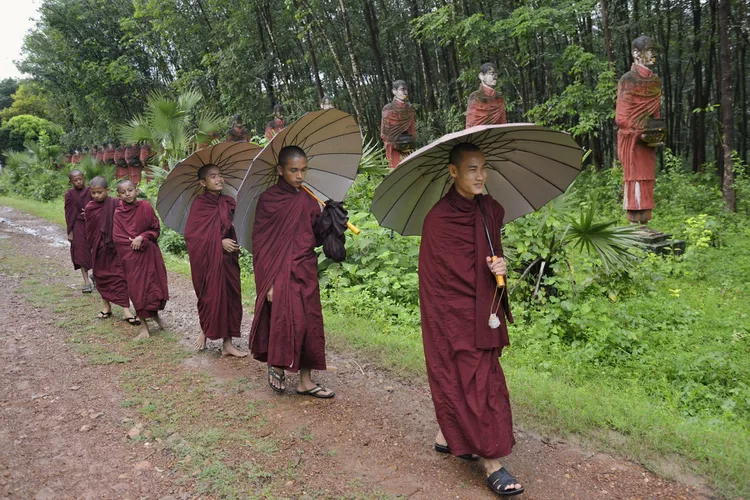Summary
Traveling During Monsoon Season in Southeast Asia
Throughout Southeast Asia, the term “monsoon season” typically denotes the s southwest monsoon, a period when prevailing winds blow from warm equatorial seas, bringing significant rainfall and storms. This season typically begins in May or June, peaks between August and October (typhoon season in Vietnam and the Philippines), and concludes by November.
The weather during the monsoon is characterized by rain and overcast skies. Generally, areas affected by this phenomenon experience infrequent sunny days interspersed with prolonged periods of rainfall. As July transitions into August, rainfall intensifies, with tropical depressions sometimes evolving into storms or typhoons originating from the Pacific Ocean, impacting the Philippines and Vietnam.
By December or January, the wind shifts direction, bringing cold, dry air from China and Siberia into the region, marking the onset of the dry season, which typically lasts until May, setting the stage for the next monsoon.

How the Monsoon Season Affects Southeast Asia’s Destinations
Countries near the equator, such as Indonesia, Malaysia, southern Philippines, and Singapore, enjoy a tropical equatorial climate that remains consistently humid and wet year-round. These regions do not experience the dramatic climatic shifts seen elsewhere, such as typhoons, nor do they have extended dry periods.
The impact of the monsoon is felt more acutely across the rest of Southeast Asia as the rainy season affects many popular tourist locations. For instance, the beach areas of Phuket and Koh Chang in Thailand experience perilous rip currents during this season, claiming several lives annually, particularly tourists unaware of the dangerous tides. In June 2013, three tourists tragically drowned due to these rip currents.
In Vietnam, the river adjacent to the historic town of Hoi An encounters annual flooding, with the Tan Ky Old House showcasing high-water marks for visitors. In severe cases, tourists may find themselves confined to their hotels or, worse, victims of flash flooding.
Meanwhile, in Siem Reap, Cambodia, the monsoon climate brings a positive change, enhancing the visual appeal of the Angkor temples. According to experts, “The Angkor temples are at their aesthetic best during the wet season,” as the surrounding moats are full and the lush jungle vividly highlights the stone structures.
In the Philippines, Boracay’s beach dynamics shift with the southwest winds making White Beach treacherous for swimmers. Local establishments erect transparent plastic shields to fend off flying sand, while tourist activity moves predominantly to Balabag Beach, which remains protected from severe winds.
Conversely, Bali’s monsoon season is opposite that of its northern counterparts, with its peak rainfall occurring from December to March. While Vietnam and the Philippines brace for typhoons from June to September, Bali enjoys its dry and cool season.
Mobility during the monsoon may be challenging, as some ferry services stop due to safety concerns, and certain overland routes may be impassable due to flooding. Flights can also face cancellations or delays during this rainy period, which might disrupt travel plans.

Pros and Cons of Monsoon Season Travel
Traveling during monsoon season offers unique advantages, which can even outweigh some of the challenges.
- Off-peak prices and capacity: Hotel rates and airfare can drop significantly during the rainy season, sometimes by up to sixty percent compared to peak season. With fewer tourists, local transportation tends to be less crowded, making travel easier.
- Cooler weather: Following the hottest months of the year, the monsoon’s afternoon showers provide much-needed relief, although high humidity levels can make the air feel heavy.
- More scenic sites: Iconic locations like the Angkor temples showcase enhanced beauty with full canals and verdant surroundings that invigorate the ancient stones.
However, it’s important to recognize the downsides of traveling during this period, which include:
- Greater health hazards: A variety of diseases emerge during the rainy season, with mosquito bites potentially leading to illnesses such as dengue fever. Contamination of groundwater can spread diseases like cholera, hepatitis, leptospirosis, and food poisoning.
- Riskier travel: While navigating flooded areas, travelers could encounter dangerous rip tides at beach resorts or risk flash floods at river-adjacent locations.
- Reduced travel options: Flooded roads may hinder ground transportation, while flight cancellations due to inclement weather can restrict travel flexibility.

Dos and Don’ts of Monsoon Season Travel
To fully enjoy your monsoon travel experience while minimizing risks, adhere to the following dos and don’ts:
- Monitor the situation: Prior to travel, check the local weather to ensure a safe journey. Most Southeast Asian countries provide online resources to keep travelers informed about the local climate.
- Pack carefully: Be mindful of the unique risks associated with the monsoon season. Utilize waterproof containers for documents and clothing, carry mosquito repellent, and have extra batteries and a flashlight ready for potential electricity outages.
- Prepare for mosquito season: Increased rainfall creates breeding grounds for mosquitoes, leading to higher risks for mosquito-borne diseases like malaria and dengue fever. Therefore, it’s crucial to pack effective repellents.
- Don’t wade in flood waters: Flooded areas can harbor diseases and hidden hazards such as open manholes. Avoid wading if possible, and ensure to wash thoroughly if you do.
- Avoid raw vegetables: The risk of fecal-to-oral transmission of diseases such as cholera is heightened, making cooked food a safer choice.
- Allow plenty of waiting time in your travel itinerary: As schedules can change unexpectedly during the rainy season, it’s wise to factor in delays and arrange for alternative accommodations if needed.





